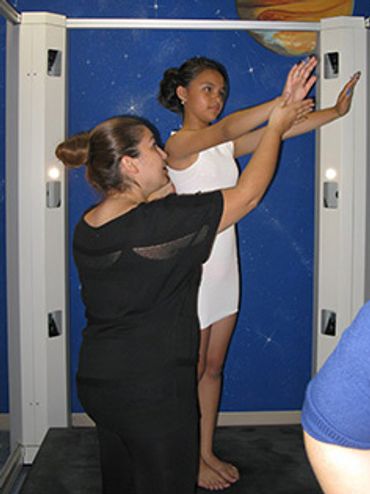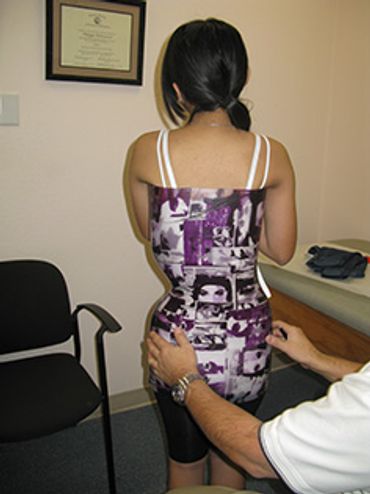Scoliosis

You Are Not Alone
Scoliosis Treatment
Scoliosis Treatment
Got Scoliosis? "Curvy Girls® support group has your back.

Scoliosis Treatment
Scoliosis Treatment
Scoliosis Treatment
There are currently no medications to treat scoliosis, but there are two other ways.

The Rigo Cheneau
Scoliosis Treatment
Our New Technology System
This is our brace of choice because over 30 years it has proven & out performed others.
Our New Technology System
Our New Technology System
Our New Technology System
We use a Scoliosis scanning machine, CAD Software System & The CANFIT-PLUS CARVER.

We Provide Custom Care
Our New Technology System
We Provide Custom Care
We treat patients with scoliosis by creating custom braces with new technology.

Scoliosis Treatment
We Can Help
There are currently no medications to treat scoliosis, nor can its onset be prevented. When scoliosis is detected, the doctor may refer the patient to an orthopedic spinal specialist for evaluation and treatment. This may consist of periodic examinations, including standing X-rays as needed to determine if the curve is increasing in size. If scoliosis is identified early, large curves may often be prevented by wearing a brace. Severe curves may require surgical treatment. There are two ways to treat scoliosis:
Custom bracing: If the curvature is below 45 degrees, a surgical operation is not necessary to treat scoliosis.
Surgical: If the curvature is above 45 degrees, a surgical operation is currently the only way to treat scoliosis.
The Rigo Cheneau Brace Program
Step 1: Initial evaluation/scanning
Step 1: Initial evaluation/scanning
Step 1: Initial evaluation/scanning

At this appointment, X-Ray and report from the Orthopedic Physician are reviewed. After we review the x-rays we talk a scanning and measurements. Then we get to work on preparing a custom made brace. We also address concerns of our patients and provide information on scoliosis.
The Rigo Cheneau Brace
Step 1: Initial evaluation/scanning
Step 1: Initial evaluation/scanning

The Rigo Cheneau Brace is our brace of choice because over 30 years of experience have proven to us that it out performs other braces.
Carving
Step 1: Initial evaluation/scanning
Step 2: Fitting of the brace

....
Step 2: Fitting of the brace
Step3: First x-ray in the brace
Step 2: Fitting of the brace

This is a long appointment (typically 2 hours) because we want to make sure each brace feels and fits right. The first time our patients wear the brace, it may look and feel weird, but we aim to make it as comfortable as possible. We offer support suggestions and clothing advice.
Step3: First x-ray in the brace
Step3: First x-ray in the brace
Step3: First x-ray in the brace

(Timing: 2-3 weeks after step 2) The brace should have been worn full time if possible. The x-ray in brace and the report from the Orthopedic physician is reviewed and base on that adjustments are made to the brace.
Step4: Follow up appointment
Step3: First x-ray in the brace
Step3: First x-ray in the brace

(Timing: every 6-8 weeks) Patients growth, brace fit and use must be monitored.
Our New Technology Scoliosis Scanning System
3D Measurement Device
The CANFIT-PLUS CARVER
3D Measurement Device

he 3D scanning device is quick and accurate. Optical casting is non-invasive, eliminates plaster casts, and the need for prolonged direct contact with the patient. Called ComfORTAC, it acquires 360 degrees measurements of a patients body and legs using structured light projection. The result scan is used by our CAD software to design orthopedic devices. Exact physical reference points are recorded directly from their position on the patient. These measurements are exactly reproduced, and stored to the computer.
- The 3D measuring device takes two pictures from the patient: frontal and profile. The software automatically finds the silhouette and calculate the 3D model.
- By acting directly on the patient’s contour, the 3D model is automatically modified. The resulting model fits the patient’s contour perfectly
CAD Software System
The CANFIT-PLUS CARVER
3D Measurement Device

This system provides an integrated suite of tools for acquiring shape data, designing and modifying shapes, and carving positive models.
- Accurate and efficient – CAD software models data from the 3D scan and enables the operator to make appropriate corrections.
- Working with an actual 3D image of the patient, measurements are reproduced exactly to create a viewable virtual cast.
- The electronic data is automatically stored. 3D monitoring and adjustments are made if needed as the treatment progresses.
The CANFIT-PLUS CARVER
The CANFIT-PLUS CARVER
The CANFIT-PLUS CARVER

The CANFIT-PLUS CARVER is designed to carve industry standard polyurethane foam blanks, handling shapes and sizes ranging from small upper extremities to very large spinal shapes.
- The 3D model from the CAD system is sent to another machine, the CANFIT-PLUS milling machine, a computer numerically controlled (CNC) carver which produces a polyurethane positive model of the socket or brace.
- The unique software enables environmentally safe and economical reuse of polyurethane blocks.
- The carver features advanced design, large capacity and extreme accuracy.

We Provide Custom Care
Custom Braces
At O&P In Motion Inc., we treat patients with scoliosis using custom braces. Most facilities take a plaster mold to cast the brace. We use a Scoliosis scanning machine instead! The advantages in using the Scoliosis scanning system are:
- Faster than plaster casting
- More precise and accurate
- No plaster mold impression/comfort for the patient
- The measurement is exactly reproduced
- The professional works on the actual 3D image of the patient (not model)
The Process


















Frequently Asked Questions
Please reach us at phil@opinmotion.com if you cannot find an answer to your question.
Scoliosis is a three-dimensional curvature of the spine. A normal spine is straight when viewed from the front or the back. Normally, when viewed from the side the spine curves backwards in the chest area (kyphosis) and forward in the waist area (lordosis). When viewed from the top down, all of the vertebrae should be facing forward. However, with scoliosis the spine curves to one side or the other in the thoracic and/or lumbar areas. From the top looking down through the center of the spine, some of the vertebrae are twisted which causes the ribs attached to the vertebrae to protrude, usually on the right side. Scoliosis is a condition that may appear in more than one member of a family in the same or different generations. It does not develop as a result of anything that a child or her parents did or failed to do. Poor posture or carrying a heavy book bag does not case scoliosis. Scoliosis is a spinal deformity that usually appears during adolescence, although it may appear in younger children as well.
There are many causes for scoliosis. About 80%-85% of the patients have a type called IDIOPATHIC scoliosis. This means “no known cause.” Idiopathic scoliosis often runs in families and appears to be due to genetic or hereditary factors. It is not known what “triggers” the development of the curve or why some curves progress more than others. Scoliosis may occur in children who are otherwise perfectly healthy. Also, scoliosis may be caused by NERVE AND MUSCLE DISORDERS, such as cerebral palsy, muscular dystrophy and polio. Other known causes of scoliosis include: CONGENITAL which is caused by abnormalities in the formation of the vertebrae present at birth, CONNECTIVE TISSUE DISORDERS such as Down’s Syndrome. Early diagnosis of the cause of scoliosis can aid in the proper treatment. During adolescence scoliosis usually produces no pain and may be difficult to detect. Mild scoliosis may be present for several years before it is seen. One of the easiest ways to detect it is by using the forward beding examination. Most importantly, the physician should check the child’s spine regularly until growth is complete since scoliosis may appear at any time during adolescence. The curvature may progress considerably during the last major growth spurt.
When scoliosis is mild in adults, the condition may remain unchanged or progress so slightly over the years that no serious problems may develop. However, in some people significant changes may occur. Curves may increase in size causing pain and interfering with function. In the most severe cases, breathing also maybe a problem. Osteoporosis (thinning of the bone) later in life can cause a mind curvature to increase significantly. Prevention of osteoporosis is especially important in people with scoliosis. Scoliosis in adults may be the result of a curve not treated during adolescence. Also, scoliosis may be developed later in life, as a result of degeneration of the discs and joints of the spine.
One of the most common signs of scoliosis is a prominent shoulder blade, frequently the right one. One shoulder may also be higher and the child tends to “list” to one side. The hips maybe uneven and one seems to be higher than the other. Scoliosis should not be confused with poor posture. Very often the first indication of scoliosis is that there is something wrong with the fitting of clothes. This is very apparent in girls when observing the hemline of a skirt or dress. When a child with scoliosis bends forward, the appearance of a rib prominence is one of the most striking sighs.
According to the Scoliosis Research Society, about 10% of the adolescent population has some degree of scoliosis. This means that about 1,000,000 children just in the United States have scoliosis. About one fourth of these children will require medical attention which may consist of observation for further progression of the curve, bracing or surgery, depending upon the degree of the curvature at the time of its detection. Some scoliosis may be so mild that treatment may never be necessary. Mild scoliosis occurs nearly as often in boys as in girls. More serious curves are five to eight times greater in girls than in boys. Studies conducted throughout the world show there is a very even occurrence of scoliosis. There is virtually no variation of racial or ethnic incidence.
Scoliosis Reference
© 2022 O&P In Motion Inc., All Rights Reserved
18913 Sherman Way, Reseda, CA 91335
Phone: 818.881.1785 | Fax: 818.881.7854
Office Hours: 8:00 am - 5:00 pm
Closed between 12:00 pm – 1:00 pm
This website uses cookies.
We use cookies to analyze website traffic and optimize your website experience. By accepting our use of cookies, your data will be aggregated with all other user data.